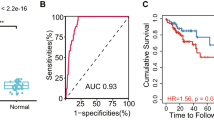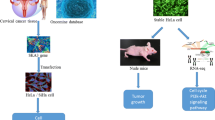Abstract
Spindle and kinetochore-associated protein 1 (SKA1) is a microtubule-binding subcomplex of the outer kinetochore that is essential for proper chromosome segregation. SKA1 is required for timely anaphase onset during mitosis, when chromosomes undergo bipolar attachment on spindle microtubules leading to silencing of the spindle checkpoint. Recently, SKA1 has been highlighted as a biomarker in some types of cancers, however, the precise role of SKA1 in gastric cancer remains unknown. In order to investigate the role of SKA1 in gastric cancer, the expression levels of SKA1 were analyzed in 56 gastric cancer samples and 54 non-neoplastic samples by immunohistochemistry, and we found SKA1 was significantly overexpressed in gastric cancer tissues. Moreover, we employed lentivirus-mediated short hairpin RNA to knockdown SKA1 in the human gastric cancer cell line MGC80-3. Functional analysis indicated that SKA1 silencing significantly inhibited cell proliferation and colony formation, as determined by MTT and colony formation assays. The depletion of SKA1 in MGC80-3 cells also led to S phase cell cycle arrest. These results suggest that SKA1 could be used for gastric cancer early diagnosis as a biomarker. It is possible to enable a potential therapy based on targeting SKA1.





Similar content being viewed by others
References
Parkin DM, Bray F, Ferlay J, Pisani P (2005) Global cancer statistics, 2002. CA Cancer J Clin 55:74–108
Jemal A, Siegel R, Xu J, Ward E (2010) Cancer statistics, 2010. CA Cancer J Clin 60:277–300. doi:10.3322/caac.20073
Shridhar R, Almhanna K, Hoffe SE, Fulp W, Weber J, Chuong MD, Meredith KL (2013) Increased survival associated with surgery and radiation therapy in metastatic gastric cancer: a surveillance, epidemiology, and end results database analysis. Cancer 119:1636–1642. doi:10.1002/cncr.27927
Wagner AD, Grothe W, Haerting J, Kleber G, Grothey A, Fleig WE (2006) Chemotherapy in advanced gastric cancer: a systematic review and meta-analysis based on aggregate data. J Clin Oncol 24:2903–2909. doi:10.1200/JCO.2005.05.0245
Yamaoka Y, Kato M, Asaka M (2008) Geographic differences in gastric cancer incidence can be explained by differences between Helicobacter pylori strains. Intern Med 47:1077–1083
Chan YW, Jeyaprakash AA, Nigg EA, Santamaria A (2012) Aurora B controls kinetochore–microtubule attachments by inhibiting Ska complex–KMN network interaction. J Cell Biol 196:563–571. doi:10.1083/jcb.201109001
Gaitanos TN, Santamaria A, Jeyaprakash AA, Wang B, Conti E, Nigg EA (2009) Stable kinetochore–microtubule interactions depend on the Ska complex and its new component Ska3/C13Orf3. EMBO J 28:1442–1452. doi:10.1038/emboj.2009.96
Raaijmakers JA, Tanenbaum ME, Maia AF, Medema RH (2009) RAMA1 is a novel kinetochore protein involved in kinetochore–microtubule attachment. J Cell Sci 122:2436–2445. doi:10.1242/jcs.051912
Theis M, Slabicki M, Junqueira M, Paszkowski-Rogacz M, Sontheimer J, Kittler R, Heninger AK, Glatter T, Kruusmaa K, Poser I, Hyman AA, Pisabarro MT, Gstaiger M, Aebersold R, Shevchenko A, Buchholz F (2009) Comparative profiling identifies C13orf3 as a component of the Ska complex required for mammalian cell division. EMBO J 28:1453–1465. doi:10.1038/emboj.2009.114
Welburn JP, Grishchuk EL, Backer CB, Wilson-Kubalek EM, Yates JR 3rd, Cheeseman IM (2009) The human kinetochore Ska1 complex facilitates microtubule depolymerization-coupled motility. Dev Cell 16:374–385. doi:10.1016/j.devcel.2009.01.011
Hanisch A, Sillje HH, Nigg EA (2006) Timely anaphase onset requires a novel spindle and kinetochore complex comprising Ska1 and Ska2. EMBO J 25:5504–5515. doi:10.1038/sj.emboj.7601426
Nara M, Teshima K, Watanabe A, Ito M, Iwamoto K, Kitabayashi A, Kume M, Hatano Y, Takahashi N, Iida S, Sawada K, Tagawa H (2013) Bortezomib reduces the tumorigenicity of multiple myeloma via downregulation of upregulated targets in clonogenic side population cells. PLoS One 8:e56954. doi:10.1371/journal.pone.0056954
Holen I, Whitworth J, Nutter F, Evans A, Brown HK, Lefley DV, Barbaric I, Jones M, Ottewell PD (2012) Loss of plakoglobin promotes decreased cell–cell contact, increased invasion, and breast cancer cell dissemination in vivo. Breast Cancer Res 14:R86. doi:10.1186/bcr3201
Sakoda T, Kasahara N, Hamamori Y, Kedes L (1999) A high-titer lentiviral production system mediates efficient transduction of differentiated cells including beating cardiac myocytes. J Mol Cell Cardiol 31:2037–2047. doi:10.1006/jmcc.1999.1035
Soneoka Y, Cannon PM, Ramsdale EE, Griffiths JC, Romano G, Kingsman SM, Kingsman AJ (1995) A transient three-plasmid expression system for the production of high titer retroviral vectors. Nucleic Acids Res 23:628–633
Tiscornia G, Singer O, Verma IM (2006) Production and purification of lentiviral vectors. Nat Protoc 1:241–245. doi:10.1038/nprot.2006.37
Tricoli JV, Bracken RB (1993) ZFY gene expression and retention in human prostate adenocarcinoma. Genes Chromosom Cancer 6:65–72
Butte JM, Duarte I, Crovari F, Guzman S, Llanos O (2007) Gastric cancer in patients older than 75 years. Surgical treatment and long-term survival. Cir Esp 82:341–345
Hartgrink HH, Jansen EP, van Grieken NC, van de Velde CJ (2009) Gastric cancer. Lancet 374:477–490. doi:10.1016/S0140-6736(09)60617-6
Kamangar F, Dores GM, Anderson WF (2006) Patterns of cancer incidence, mortality, and prevalence across five continents: defining priorities to reduce cancer disparities in different geographic regions of the world. J Clin Oncol 24:2137–2150. doi:10.1200/JCO.2005.05.2308
Hohenberger P, Gretschel S (2003) Gastric cancer. Lancet 362:305–315
Ottini L, Falchetti M, Lupi R, Rizzolo P, Agnese V, Colucci G, Bazan V, Russo A (2006) Patterns of genomic instability in gastric cancer: clinical implications and perspectives. Ann Oncol 17(Suppl 7):vii97–102. doi:10.1093/annonc/mdl960
Suzuki K, Suzuki I, Leodolter A, Alonso S, Horiuchi S, Yamashita K, Perucho M (2006) Global DNA demethylation in gastrointestinal cancer is age dependent and precedes genomic damage. Cancer Cell 9:199–207. doi:10.1016/j.ccr.2006.02.016
Guilford PJ, Hopkins JB, Grady WM, Markowitz SD, Willis J, Lynch H, Rajput A, Wiesner GL, Lindor NM, Burgart LJ, Toro TT, Lee D, Limacher JM, Shaw DW, Findlay MP, Reeve AE (1999) E-cadherin germline mutations define an inherited cancer syndrome dominated by diffuse gastric cancer. Hum Mutat 14:249–255. doi:10.1002/(SICI)1098-1004(1999)14:3<249:AID-HUMU8>3.0.CO;2-9
Nezi L, Musacchio A (2009) Sister chromatid tension and the spindle assembly checkpoint. Curr Opin Cell Biol 21:785–795. doi:10.1016/j.ceb.2009.09.007
Santaguida S, Vernieri C, Villa F, Ciliberto A, Musacchio A (2011) Evidence that Aurora B is implicated in spindle checkpoint signalling independently of error correction. EMBO J 30:1508–1519. doi:10.1038/emboj.2011.70
Cheeseman IM, Chappie JS, Wilson-Kubalek EM, Desai A (2006) The conserved KMN network constitutes the core microtubule-binding site of the kinetochore. Cell 127:983–997. doi:10.1016/j.cell.2006.09.039
Santaguida S, Musacchio A (2009) The life and miracles of kinetochores. EMBO J 28:2511–2531. doi:10.1038/emboj.2009.173
Author information
Authors and Affiliations
Corresponding author
Rights and permissions
About this article
Cite this article
Sun, W., Yao, L., Jiang, B. et al. Spindle and kinetochore-associated protein 1 is overexpressed in gastric cancer and modulates cell growth. Mol Cell Biochem 391, 167–174 (2014). https://doi.org/10.1007/s11010-014-1999-1
Received:
Accepted:
Published:
Issue Date:
DOI: https://doi.org/10.1007/s11010-014-1999-1




